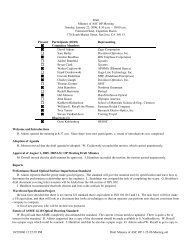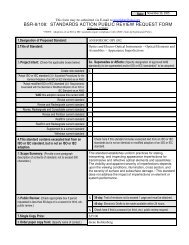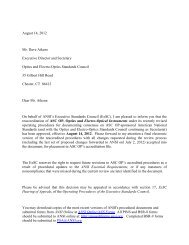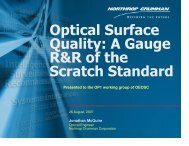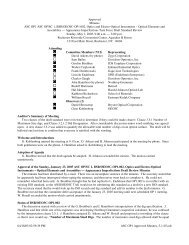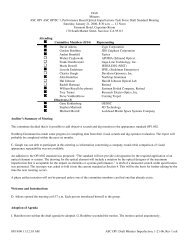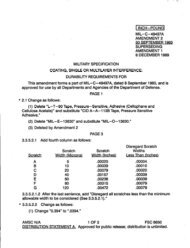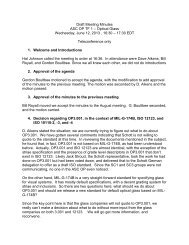INCH-POUND MIL-PRF-13830B 9 January 1997 SUPERSEDING ...
INCH-POUND MIL-PRF-13830B 9 January 1997 SUPERSEDING ...
INCH-POUND MIL-PRF-13830B 9 January 1997 SUPERSEDING ...
You also want an ePaper? Increase the reach of your titles
YUMPU automatically turns print PDFs into web optimized ePapers that Google loves.
<strong>MIL</strong>-<strong>PRF</strong>-<strong>13830B</strong><br />
APPENDIX D<br />
equal or exceed that specified for Test No. 3 of Table ID. An average shear strength<br />
less than that specified in Table ID shall cause rejection of the adhesive.<br />
D.4.5.4.4 High humidity tensile shear test. (Test No. 4 of Table ID). The<br />
humidity tensile shear test shall be in accordance with D.4.5.4.1 after the specimens<br />
have been conditioned at 71° ± 2°C and 95 to 100% relative humidity. A total of six<br />
specimens shall be tested. The average strengths shall equal or exceed that specified<br />
for Test No. 4 in Table ID. An average shear strength less than that specified in Table<br />
ID shall cause rejection of the adhesive.<br />
D.4.5.4.5 Low temperature thermal stability. The adhesive shall be evaluated for<br />
its low temperature thermal stability by placing prism assemblies, prepared as<br />
specified in D.4.4.2, in a cold box at room temperature and allowing the temperature<br />
to drop to -62.5° ± 2°C at a rate not to exceed 20°C per hour. The temperature shall<br />
be maintained for four hours, after which the specimens shall be returned to room<br />
temperature and examined to meet the requirements of D.3.4. If one or more of the<br />
test specimens fails the test, the adhesive shall be rejected. A total of five specimens<br />
shall be tested.<br />
D.4.5.4.6 Mechanical shock stability.<br />
D.4.5.4.6.1 Mechanical shock stability-low temperature. The adhesive shall be<br />
evaluated for its low temperature mechanical shock stability by testing prism<br />
assemblies, prepared as specified in D.4.4.2 in the vertical plane, in accordance with<br />
the pulse shape, peak value and time duration as specified in D.3.5.1. The<br />
specimens shall be refrigerated by placing them in a cold box at room temperature<br />
and allowing the temperature to drop to -51° ± 2°C and maintaining that temperature<br />
for two hours. The specimens shall then be removed from the cold box and mounted<br />
on a fixture of the shock test machine and then shock tested. This must be done<br />
expeditiously so that the temperature of the assembly does not increase above -40°C.<br />
The mounted prism shall first be shock tested at 250 g’s and the shock test increased<br />
at increments of 50 g’s until the 400 g level has been reached. One shock test shall<br />
be made at each level. If one or more of the test specimens fails the test, the adhesive<br />
shall be rejected. A total of five specimens shall be tested.<br />
D.4.5.4.6.2 Mechanical shock stability - High humidity. The adhesive shall be<br />
evaluated for its mechanical shock stability by testing prism assemblies in<br />
accordance with he pulse shape, peak value and time duration as specified in<br />
D.3.5.2. The specimens shall be placed in a humidity chamber at 71° ± 3°C and 95<br />
to 100% relative humidity for 24 hours. The specimens shall be removed from the<br />
humidity chamber and mounted on the fixture of a shock test machine and shock<br />
62<br />
Source: http://www.assistdocs.com -- Downloaded: 2006-05-24T15:32Z<br />
Check the source to verify that this is the current version before use.



